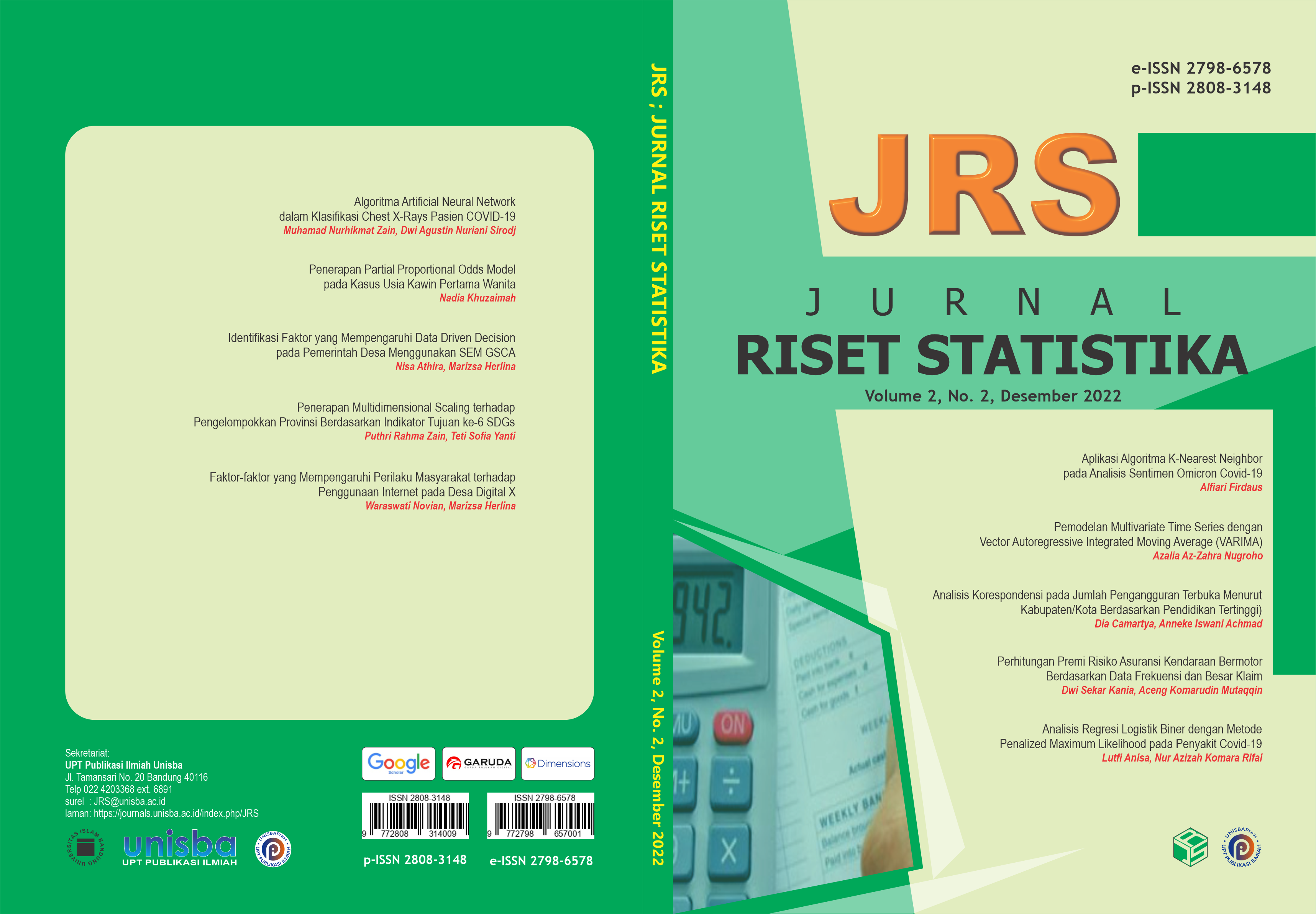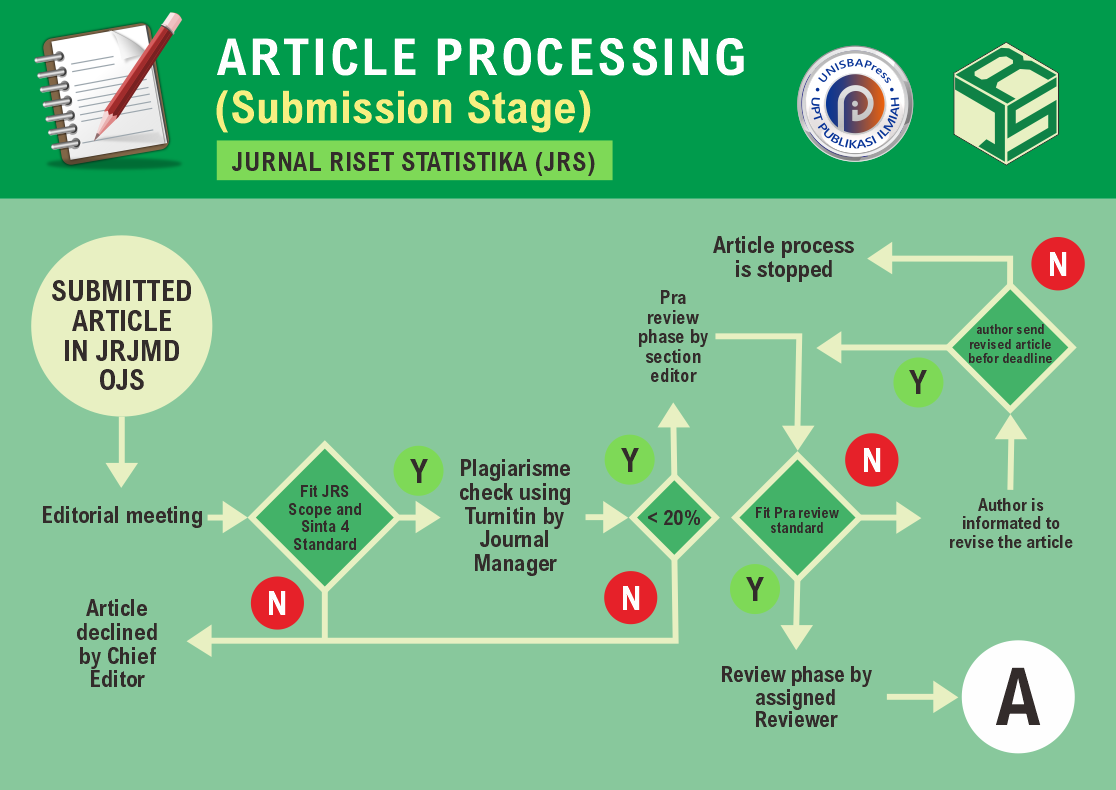Penerapan Partial Proportional Odds Model pada Kasus Usia Kawin Pertama Wanita
DOI:
https://doi.org/10.29313/jrs.v2i2.1219Keywords:
Regresi Logistik Ordinal, Proportional Odds Model, Partial Proportional Odds ModelAbstract
Abstract.
Ordinal logistic regression is a statistical method for analyzing response variables that have ordinal data scales and consist of three or more categories, while the predictor variables used can be categorical or quantitative data. The model commonly used in ordinal logistic regression is the Proportional Odds Model (POM). POM has strong assumptions that can lead to misinterpretation if the assumptions are violated, the general assumption of the model is known as the proportional odds assumption. So that an alternative model that needs to be considered when the assumptions are not met is the Partial Proportional Odds Model (PPOM), which is a model that weakens the proportionality assumption only for some predictor variables in the model. The purpose of this study is to apply PPOM in cases of women's first marriage age and what factors affect the age at first marriage based on the PPOM model. PPOM parameter estimation using Maximum Likelihood Estimation (MLE) method obtained results that are not close-form so that Newton-Raphson iteration is needed. Based on the test results, it is found that the predictor variables that affect the age at first marriage of women are education, place of residence and economy.
Abstrak.
Regresi logistik ordinal merupakan salah satu metode statistika untuk menganalisis variabel respon yang mempunyai skala data ordinal dan terdiri dari tiga kategori atau lebih, sedangkan variabel prediktor yang digunakan dapat berupa data kategori atau kuantitatif. Model yang umum digunakan dalam regresi logistik ordinal adalah Proportional Odds Model (POM). POM mempunyai asumsi kuat yang dapat menyebabkan kesalahan interpretasi jika asumsi dilanggar, asumsi umum dari model dikenal dengan asumsi proportional odds. Sehingga model alternatif yang perlu dipertimbangkan ketika asumsi tidak terpenuhi adalah Partial Proportional Odds Model (PPOM), yakni model yang melemahkan asumsi proporsionalitas hanya untuk beberapa variabel prediktor dalam model. Tujuan penelitian ini adalah mengaplikasikan PPOM pada kasus usia kawin pertama wanita dan faktor apa saja yang mempengaruhi usia kawin pertama berdasarkan model PPOM. Estimasi parameter PPOM menggunakan metode Maximum Likelihood Estimation (MLE) diperoleh hasil yang not close-form sehingga diperlukan iterasi Newton-Raphson. Berdasarkan hasil pengujian diperoleh bahwa variabel prediktor berpengaruh terhadap usia kawin pertama wanita adalah pendidikan, tempat tinggal dan ekonomi.
References
Hasna and A. I. Achmad, “Metode Regresi Probit Biner untuk Pemodelan Faktor-Faktor yang Mempengaruhi Diagnosis Penyakit Jantung,” J. Ris. Stat., pp. 28–34, 2022, doi: 10.29313/jrs.vi.721.
A. M. A., “Analisis Regresi Logistik Multinominal Untuk Mengetahui Faktor-Faktor Utama yang Mempengaruhi Keputusan Mahasiswa Matematika UNM Setelah Selesai S1,” Universitas Negeri Makassar, 2011.
D. W. Hosmer Jr., S. Lemeshow, and R. X. Sturdivant, Applied Logistic Regression, Third Edition. John Wiley & Sons, Inc., 2013.
S. Das and R. M. Rahman, “Application of ordinal logistic regression analysis in determining risk factors of child malnutrition in Bangladesh.,” Nutr. J., vol. 10, p. 124, Nov. 2011, doi: 10.1186/1475-2891-10-124.
A. Dolgun and O. Saracbasi, “Assessing proportionality assumption,” Stat. Interface, vol. 7, pp. 275–295, 2014.
M. N. S. Abreu, A. L. Siqueira, C. S. Cardoso, and W. T. Caiaffa, “Ordinal logistic regression models: application in quality of life studies.,” Cad. Saude Publica, vol. 24 Suppl 4, pp. s581-91, 2008, doi: 10.1590/s0102-311x2008001600010.
D. G. Kleinbaum and M. Klein, Logistic Regression: A Self Learning Text (3rd ed). New York: Springer., 2010.
C. D. Manning, P. Raghavan, and H. Schutze, An Introduction to Modern Information Retrieval, Online Edi., vol. 53, no. 9. Cambridge: Cambridge University Press, 2009. doi: 10.1108/00242530410565256.
B. R., Assessing proportionality in the proportional odds model for ordinal logistic regressio. 1990.
R. Williams, “Generalized ordered logit/partial proportional odds models for ordinal dependent variables,” Stata J., vol. 6, no. 1, pp. 58–82, 2006, doi: 10.1177/1536867x0600600104.
A. Agresti, Categorical Data Analysis, 2nd Edition. New York, 2003.













